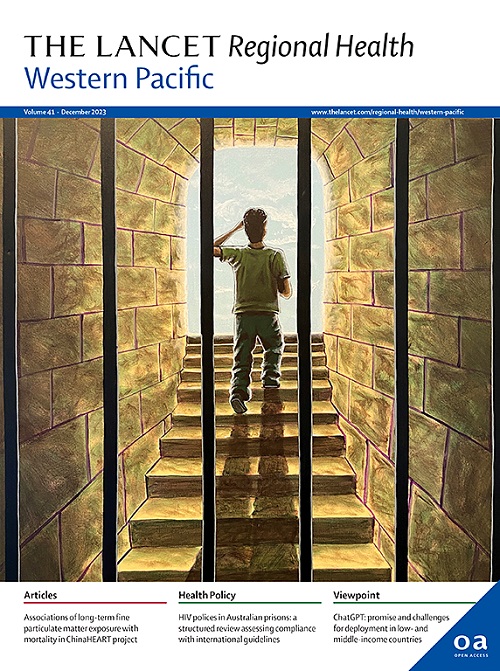中国大陆在获得EV-A71疫苗之前和期间手足口病暴发流行病学:2011 - 2023年暴发监测数据分析
IF 7.6
1区 医学
Q1 HEALTH CARE SCIENCES & SERVICES
引用次数: 0
摘要
背景手足口病是一种常见的儿童传染病,在中国大陆造成了沉重的疾病负担。自2016年以来,已有三种肠病毒A71 (EV-A71)疫苗在中国获得许可和使用。我们的研究描述了引入EV-A71疫苗后手足口病暴发流行病学特征的变化。方法利用2011-2023年中国疾病预防控制中心报告的手足口病暴发数据,比较EV-A71疫苗许可和获得前后手足口病暴发的特点。我们使用多元回归模型确定了与疫情规模相关的危险因素,并使用地方空间关联指标(Anselin local Moran’s I)探索了县级疫情集群的模式。在2011-2023年期间,报告了2838例手足口病暴发,每个病例都超过10例纳入了我们的研究。在这些爆发个案中,共有53,958宗手足口病个案及17人死亡。中位攻击率为0.07% (IQR = 0.04%-0.13%),中位爆发持续时间为14天(IQR = 9-21)。疫情在开学前开始,并在第16-25周达到高峰;大多数(87.95%)发生在幼儿园,其次是小学或中学(6.69%)。柯萨奇病毒A16 (CV-A16)引起的手足口病暴发占54.94%,EV-A71引起19.77%,CV-A6引起8.99%,CV-A10引起0.53%,其他肠道病毒引起15.76%。EV-A71疫苗作为非国家免疫规划(NIP)疫苗投入市场后,南方省份由EV-A71引起的疫情比例下降到2.93%,北方省份下降到4.84%,CV-A16、CV-A6、CV-A10等肠道病毒的比例上升。在获得EV-A71疫苗之前,高-高聚集性病例发生在9个省的37个县,在引入疫苗后扩大到9个省的117个县,主要是在南部省份。EV-A71疫苗进入中国市场后,由EV-A71引起的手足口病暴发减少,由CV-A16、CV-A6和CV-A10引起的手足口病暴发增加。手足口病的频谱变化和疫情热点的扩大与疫苗的引入有关,要求开发多肠道病毒疫苗来控制手足口病的暴发。重大疾病流行病学教育部重点实验室;网络-物理-社会三空间重大传染病防控机制(2023YFC2308702)。本文章由计算机程序翻译,如有差异,请以英文原文为准。
Epidemiology of hand, foot, and mouth disease outbreaks before and during availability of EV-A71 vaccine in China's mainland: analysis of outbreak surveillance data from 2011 to 2023
Background
Hand, foot, and mouth disease is a common contagious illness of childhood that causes a heavy disease burden in China's mainland. There are three enterovirus A71 (EV-A71) vaccines licensed and used in China since 2016. Our study describes changes in epidemiological characteristics of HFMD outbreaks following EV-A71 vaccine introduction.
Methods
Using HFMD outbreak data notified to China CDC during 2011–2023, we compared characteristics of HFMD outbreaks before and after EV-A71 vaccine licensure and availability. We determined risk factors associated with outbreak size with a multivariate regression model and explored county-level patterns of outbreak clusters using local indicators of spatial association (Anselin Local Moran's I).
Findings
During 2011–2023, there were 2838 HFMD outbreaks reported with more than ten cases each that were included in our study. There were 53,958 HFMD cases and 17 deaths in the included outbreaks. The median attack rate was 0.07% (IQR = 0.04%–0.13%) and the median outbreak duration was 14 days (IQR = 9–21). Outbreaks began before school seasons started and peaked during weeks 16–25; most (87.95%) occurred in kindergartens, followed by primary or secondary schools (6.69%). Coxsackievirus A16 (CV-A16) caused 54.94% of the HFMD outbreaks, EV-A71 caused 19.77%, CV-A6 caused 8.99%, CV-A10 caused 0.53%, and other enteroviruses caused 15.76%. After EV-A71 vaccine was introduced into the market as a non-National Immunization Program (NIP) vaccine, the proportion of outbreaks caused by EV-A71 declined to 2.93% in the southern provinces and 4.84% in the northern provinces, and CV-A16, CV-A6, CV-A10, and other enteroviruses increased in proportion. Before EV-A71 vaccine availability, high-high clusters occurred in 37 counties of nine provinces, expanding to 117 counties of nine provinces after vaccine introduction, mainly into southern provinces.
Interpretation
After EV-A71 vaccine was introduced to the market in China, fewer HFMD outbreaks were caused by EV-A71 and more were caused by CV-A16, CV-A6, and CV-A10. The changes of spectrum for HFMD and expansion of outbreaks hotspots associated with vaccine introduction calls for multi-enterovirus vaccine development for controlling HFMD outbreaks.
Funding
Key Laboratory of Epidemiology of Major Diseases (Peking University), Ministry of Education; Prevention and Control Mechanisms for Major Infectious Diseases in the Cyber-Physical-Social Tri-Space (2023YFC2308702).
求助全文
通过发布文献求助,成功后即可免费获取论文全文。
去求助
来源期刊

The Lancet Regional Health: Western Pacific
Medicine-Pediatrics, Perinatology and Child Health
CiteScore
8.80
自引率
2.80%
发文量
305
审稿时长
11 weeks
期刊介绍:
The Lancet Regional Health – Western Pacific, a gold open access journal, is an integral part of The Lancet's global initiative advocating for healthcare quality and access worldwide. It aims to advance clinical practice and health policy in the Western Pacific region, contributing to enhanced health outcomes. The journal publishes high-quality original research shedding light on clinical practice and health policy in the region. It also includes reviews, commentaries, and opinion pieces covering diverse regional health topics, such as infectious diseases, non-communicable diseases, child and adolescent health, maternal and reproductive health, aging health, mental health, the health workforce and systems, and health policy.
 求助内容:
求助内容: 应助结果提醒方式:
应助结果提醒方式:


